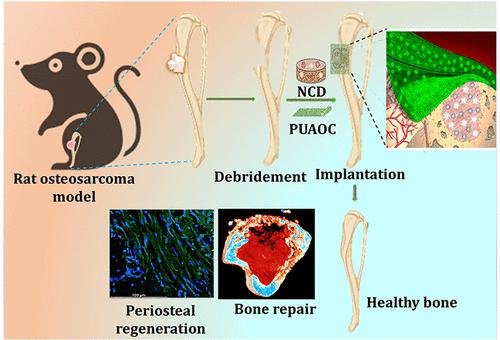当前位置:
X-MOL 学术
›
ACS Appl. Mater. Interfaces
›
论文详情
Our official English website, www.x-mol.net, welcomes your
feedback! (Note: you will need to create a separate account there.)
Exosome-Functionalized, Drug-Laden Bone Substitute along with an Antioxidant Herbal Membrane for Bone and Periosteum Regeneration in Bone Sarcoma
ACS Applied Materials & Interfaces ( IF 8.3 ) Pub Date : 2023-02-07 , DOI: 10.1021/acsami.2c18308 Sneha Gupta 1 , Irfan Qayoom 1 , Purva Gupta 1 , Archita Gupta 2 , Prerna Singh 1 , Sneha Singh 2 , Ashok Kumar 1, 3, 4, 5, 6
ACS Applied Materials & Interfaces ( IF 8.3 ) Pub Date : 2023-02-07 , DOI: 10.1021/acsami.2c18308 Sneha Gupta 1 , Irfan Qayoom 1 , Purva Gupta 1 , Archita Gupta 2 , Prerna Singh 1 , Sneha Singh 2 , Ashok Kumar 1, 3, 4, 5, 6
Affiliation

|
Developing advanced methods for effective bone reconstructive strategies in case of critical bone defects caused by tumor resection, trauma, and other implant-related complications remains a challenging problem in orthopedics. In the clinical management of bone diseases, there is a paradigm shift in using local drugs at the injury site; however, the dead space created during the surgical debridement of necrotic bone and soft tissues (periosteum and underlying muscle) leads to ineffective bone formation, thereby leading to secondary complications, and thus calls for better regenerative approaches. In this study, we have utilized an exosome-functionalized doxorubicin-loaded biodegradable nanocement (NC)-based carrier along with a Cissus quadrangularis (CQ) extract-laden antioxidant herbal membrane for simultaneously managing the periosteum as well as bone formation in the tumor resection model of osteosarcoma. We initially evaluated the efficacy of scaffolds for in vitro mineralization and bone formation. To examine the in vivo effectiveness, we developed a human osteosarcoma cell line (Saos-2)-induced tumor xenograft model with a critical-sized bone defect. The findings revealed that doxorubicin released from NC was successful in killing the tumor cells and was present even after 30 days of implantation. Additionally, the incorporation of exosomes aided the bone formation, resulting in around a 2.6-fold increase in the bone volume compared to the empty group as evaluated by micro-CT. The herbal membrane assisted in the development of periosteum and mineralizing bone callous as validated through histological and immunofluorescence analysis. Thus, our findings describe a one-step biomaterial-based cell-free approach to regenerate bone in osteosarcoma and prevent further fracture due to the complete development of periosteum and lost bone.
中文翻译:

外泌体功能化、载药骨替代品与抗氧化草药膜一起用于骨肉瘤的骨和骨膜再生
针对肿瘤切除、创伤和其他植入相关并发症引起的严重骨缺损,开发有效的骨重建策略的先进方法仍然是骨科中的一个具有挑战性的问题。在骨科疾病的临床治疗中,在损伤部位使用局部药物的模式发生了转变;然而,手术清创坏死骨和软组织(骨膜和底层肌肉)时产生的死腔会导致骨形成无效,从而导致继发性并发症,因此需要更好的再生方法。在这项研究中,我们利用外泌体功能化的负载阿霉素的可生物降解纳米水泥(NC)基载体以及富含白粉藤(CQ)提取物的抗氧化草药膜来同时管理肿瘤切除中的骨膜和骨形成骨肉瘤模型。我们最初评估了支架在体外矿化和骨形成方面的功效。为了检查体内有效性,我们开发了人骨肉瘤细胞系(Saos-2)诱导的具有临界尺寸骨缺损的肿瘤异种移植模型。研究结果显示,NC 释放的阿霉素成功杀死了肿瘤细胞,甚至在植入 30 天后仍然存在。此外,外泌体的掺入有助于骨形成,根据微型 CT 评估,与空组相比,骨体积增加了约 2.6 倍。通过组织学和免疫荧光分析验证,草药膜有助于骨膜的发育和矿化骨痂。 因此,我们的研究结果描述了一种基于生物材料的一步式无细胞方法来再生骨肉瘤中的骨,并防止由于骨膜的完全发育和骨质流失而导致的进一步骨折。
更新日期:2023-02-07
中文翻译:

外泌体功能化、载药骨替代品与抗氧化草药膜一起用于骨肉瘤的骨和骨膜再生
针对肿瘤切除、创伤和其他植入相关并发症引起的严重骨缺损,开发有效的骨重建策略的先进方法仍然是骨科中的一个具有挑战性的问题。在骨科疾病的临床治疗中,在损伤部位使用局部药物的模式发生了转变;然而,手术清创坏死骨和软组织(骨膜和底层肌肉)时产生的死腔会导致骨形成无效,从而导致继发性并发症,因此需要更好的再生方法。在这项研究中,我们利用外泌体功能化的负载阿霉素的可生物降解纳米水泥(NC)基载体以及富含白粉藤(CQ)提取物的抗氧化草药膜来同时管理肿瘤切除中的骨膜和骨形成骨肉瘤模型。我们最初评估了支架在体外矿化和骨形成方面的功效。为了检查体内有效性,我们开发了人骨肉瘤细胞系(Saos-2)诱导的具有临界尺寸骨缺损的肿瘤异种移植模型。研究结果显示,NC 释放的阿霉素成功杀死了肿瘤细胞,甚至在植入 30 天后仍然存在。此外,外泌体的掺入有助于骨形成,根据微型 CT 评估,与空组相比,骨体积增加了约 2.6 倍。通过组织学和免疫荧光分析验证,草药膜有助于骨膜的发育和矿化骨痂。 因此,我们的研究结果描述了一种基于生物材料的一步式无细胞方法来再生骨肉瘤中的骨,并防止由于骨膜的完全发育和骨质流失而导致的进一步骨折。


















































 京公网安备 11010802027423号
京公网安备 11010802027423号